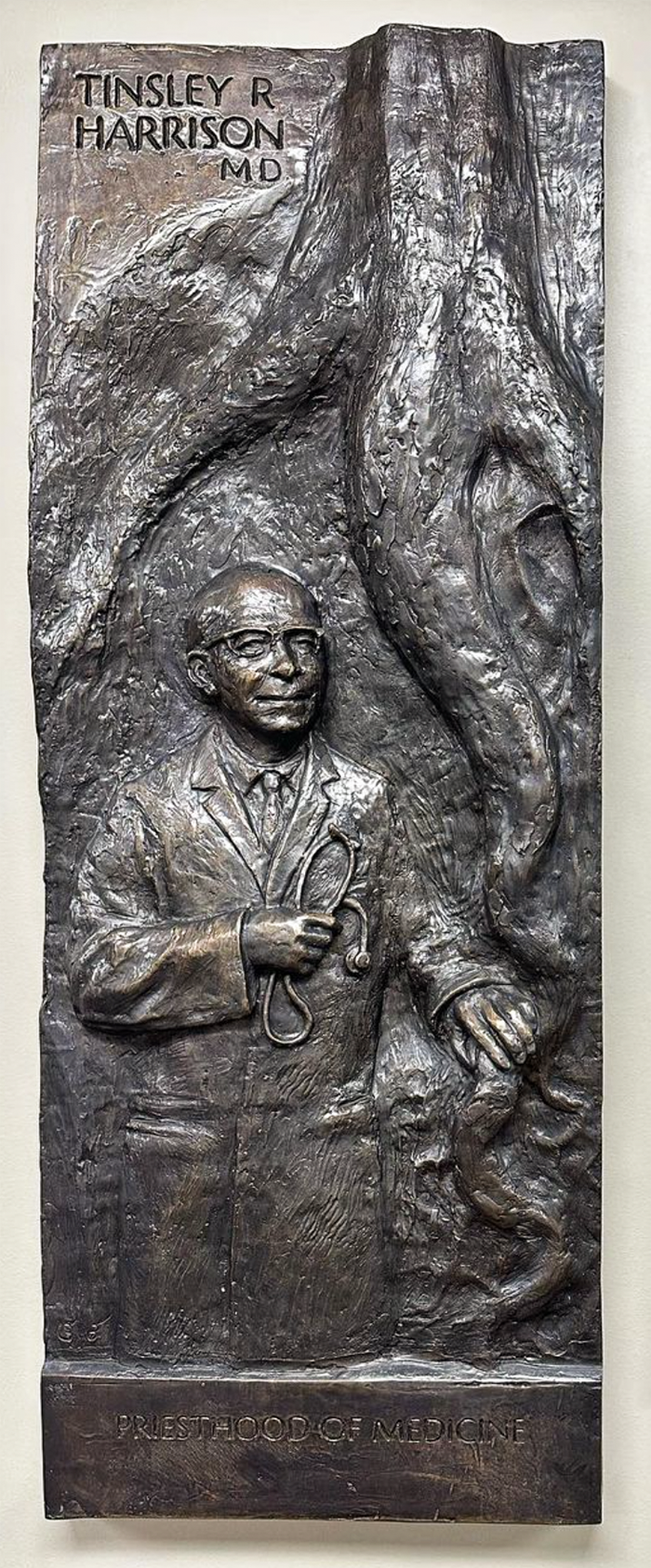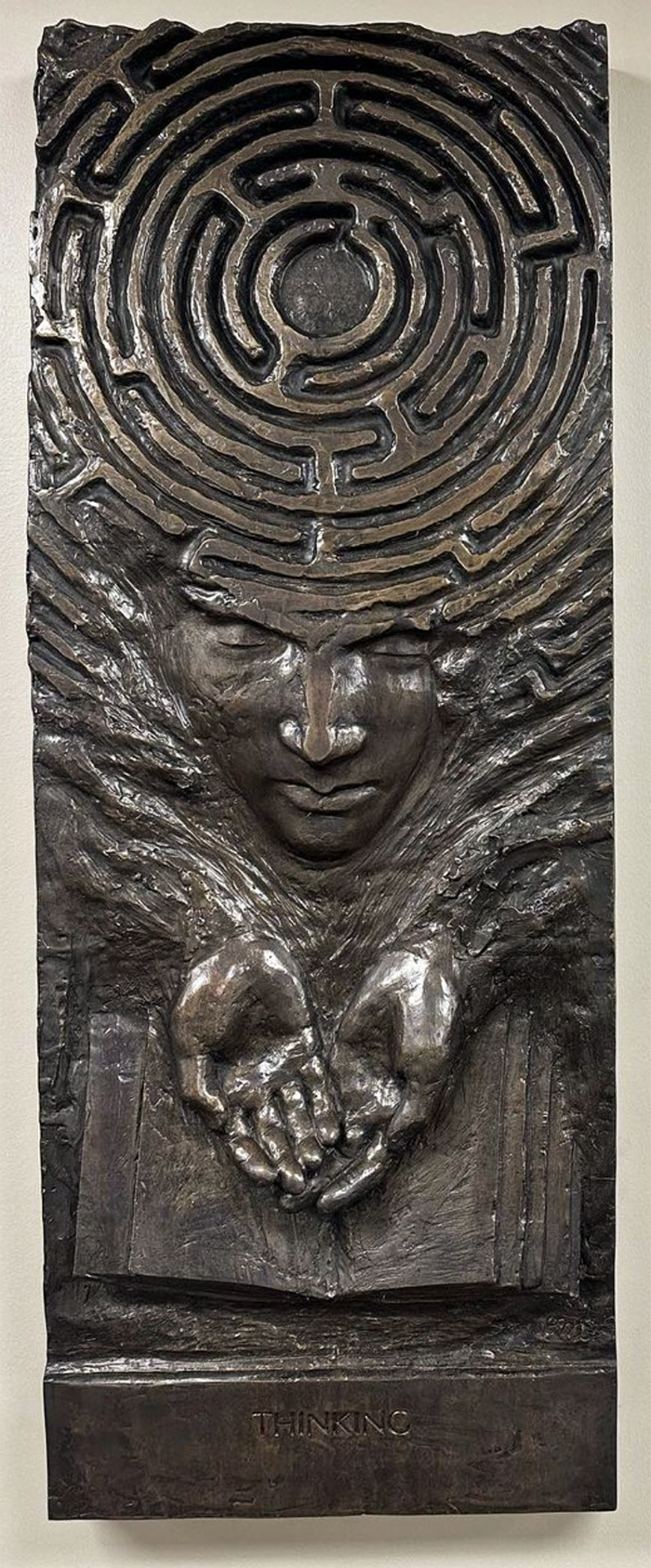On July 27, 2023, beloved alumni dedicated five sculptures to the Tinsley Harrison Internal Medicine Residency Program to honor Harrison’s legacy. The sculptures represent values passed down from Harrison to those impacted by his influential leadership. The sculptures were presented to inspire current and future residents to embrace and uphold the values represented, and continue passing down the legacy that unites generations of UAB Tinsley Harrison Internal Medical residents.
 Priesthood of Medicine
Priesthood of Medicine
Given by Dr. and Mrs. Craig Coe and family in honor of Dr. Howell Dean Coe, Jr.
On April 15, 1970, Dr. Harrison received the American College of Physicians Distinguished Teacher Award at the 51st Annual Session of the ACP in Philadelphia, Pennsylvania. In his acceptance speech, which was subsequently published in the Annals of Internal Medicine (1970;73:475-478), he discussed the three roots of the medical tree: the scientific root ("the youngest but thickest"), the skills or art of medicine ("the intermediate root"), and the priesthood of medicine (the "older and deeper root") by which the physician is the treatment.
In the early 1980s, a UAB internal medicine first-year resident was on-call overnight. He was tasked with pronouncing the death of one of his fellow intern's patients, who was a middle-aged cerebral palsy patient who required total care and whose death was expected. When the patient's mother saw the name tag of the weary-eyed intern, she asked if he was related to the physician who had cared for her son for four decades. The intern responded, "Yes, yes I am." When her son was born, she had been told by many that nothing could be done for him and that she should take him home to die. Instead, she took him to the intern's father, who told her what she already knew — that there was no known remedy. He then said, "I will help you, and I will not give up on you." For the next forty years, he exemplified the priesthood of medicine to the patient and his family.
 Contagious Fire
Contagious Fire
Given by Dr. Craig Coe and Dr. George Karam in honor of Dr. Glenn Cobbs
The inaugural Legacy Dinner sponsored by the Legacy Endowed Support Fund for the Tinsley Harrison Internal Medicine Residency was held on June 26, 2012, at the home of Nanita and Glenn Cobbs. At the event, Dr. Cobbs spoke of the upcoming third-year residents about an attribute strongly espoused by Dr. Harrison to be of importance in physicians: Contagious Fire. At the time of his comments, that term was not in any place in the published medical literature. In a highly characteristic way, Dr. Cobbs said the following about Contagious Fire: “I haven’t heard that term from anyone else." What he meant was somebody that turns you on to do a better job, you might try to cultivate that. Try to perform and act and be around other people so that they’ll say, ‘Holy smoke, that person is really excited.’”
In a subsequent interview in the Fall/Winter 2020 edition of Letters to Tinsley, Dr. Cobbs elaborated on Contagious Fire, commenting that the term included Dr. Harrison's belief that it was important for a mentor to be enthusiastic about medicine and to transmit that to others.
Contagious Fire might be considered as values, enthusiasm, and commitment that an individual instills in others, thereby emboldening them to perform at the level that might not otherwise be possible. In essence, it is a formative gift that heightens success and fosters joy.
 Thinking
Thinking
Given by Drs. Ira and Cynthia Gore in honor of Dr. Bill Dismukes
Shortly after the death of Dr. Harrison on August 4, 1978, there was a quote attributed to him that began to be recurrently heard on the wards at UAB: “I am not here to teach you facts. If I wanted to know facts, I would tell you to read my book. I am here to teach you to think.”
Dr. Harrison's focus on thinking predated the 1950 first edition of Harrison's Principles of Internal Medicine. In a letter to Dr. Coy C. Carpenter, Dean of the Wake Forest University School of Medicine, dated December 21, 1940, "and written during the process of seeking a purpose of clinics and lectures, will be primarily to stimulate thinking rather than to teach facts."
The labyrinth, with its single path and no dead ends, symbolizes a learning philosophy that focuses on the reflection and creativity that lead to new thought. In contrast to learning that prioritizes the acquisition of pre-established facts articulated on the pages of a book, the labyrinth encourages having blank pages on which learners can record their own thoughts. The permission to think rather than to merely acquire facts endeared Dr. Harrison to all who learned from him.
 E=hH2
E=hH2
Given by Dr. Joel Silverberg and Dr. Vince Tumminello in honor of Dr. Claude Bennett
Chapter 10 of Dr. Harrison’s book, “Your Future Health Care: The Challenge and the Promise through Better Education,” focuses on some “educational equations” that Dr. Harrison felt were important for a physician. One was an adaptation of Einstein’s special theory of relativity (E=mc2), which Dr. Harrison modified to be E=hH2. In that version, “E” represented education, “h” was the combination of medical knowledge, i.e., one’s head, and “H” was squared to represent the exponential impact of the teacher’s heart.
Dr. Harrison's emphasis on the importance of the heart of a teacher of medicine was recurrently stated. In his Forward to the book, "Tinsley, MD, Teacher of Medicine" (NewSouth Books, Montgomery AL, 20151), Dr. Joe LaRussa made note of the important relations that is more about a person's willingness to teach than about them being smart. He wrote that Dr. Harrison believed and said, "Learning is more a matter of the heart than the brain."
This important message regarding teaching transcends the traditional relationship between faculty member and medical student or resident. It reminds us that the word doctor derives from the Latin word docere, meaning "to teach" and mandates that physician teaching responsibility is to all, including patients. The emphasis on heart is exceedingly important in this context.
 Moral and Mental Discipline
Moral and Mental Discipline
Given by Dr. Susan Karam and Dr. Fred Cerise in honor of all Internal Medicine residents who have trained at UAB.
Tinsley Harrison's father, Dr. Groce Harrison, was the protege of Sir William Osler. The younger Dr. Harrison acknowledged Osler's "superb" teaching skill at the bedside but went on to write in "Your Future Health Care: The Challenge and the Promise Through Better Education" (Warren H. Green, Inc., St. Louis MO, 1974), that, "the place where Osler led his pupils toward 'moral and mental discipline' was his own home. My father mentioned to me again and again the invitation that Osler so frequently extended: 'Harrison, I want you to have dinner with me tomorrow night. Come at six and leave at eight.'"
Like Osler, Dr. Tinsley Harrison invited students to his home for dinner. After the meal a paper would be discussed with the intent of fostering a lively discussion. In an interview about this, Harrison insightfully noted, "there was a close emotional bond between teacher and student, not just an intellectual bond, and that's the difference between education and instruction."
Dr. Harrison's concept of moral and mental discipline is aligned with the ongoing challenge of achieving some degree of balance between the personal and professional dimensions of both medical education and clinical practice. The synergy that occurs with this balance is foundational in the commitment to "Excellence without Ego."


